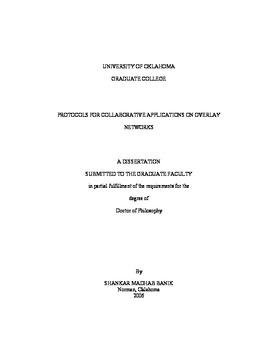| dc.contributor.advisor | Radhakrishnan, Sridhar, | en_US |
| dc.contributor.author | Banik, Shankar Madhab. | en_US |
| dc.date.accessioned | 2013-08-16T12:20:03Z | |
| dc.date.available | 2013-08-16T12:20:03Z | |
| dc.date.issued | 2006 | en_US |
| dc.identifier.uri | https://hdl.handle.net/11244/989 | |
| dc.description.abstract | Third, we address the limitations of traditional multicasting models. Towards this, we propose a model where a source node has different switching time for each child node and the message arrival time at each child depends on the order in which the source chooses to send the messages. This model captures the heterogeneous nature of communication links and node hardware on the overlay network. Given a multicast tree with link delays and generalized switching delay vectors at each non-leaf node, we provide an algorithm which schedules the message delivery at each non-leaf node in order to minimize the delay of the multicast tree. | en_US |
| dc.description.abstract | First, we consider the floor control problem wherein the participating users coordinate among themselves to gain exclusive access to the communication channel. To solve the floor control problem, we present an implementation and evaluation of distributed Medium Access Control (MAC) protocols on overlay networks. As an initial step in the implementation of these MAC protocols, we propose an algorithm to construct an efficient communication channel among the participating users in the overlay network. We also show that our implementation scheme (one of the first among decentralized floor control protocols) preserves the causal ordering of messages. | en_US |
| dc.description.abstract | Our research is focused on the development of algorithms for the construction of overlay networks that meet the demands of the distributed applications. In addition, we have provided network protocols that can be executed on these overlay networks for a chosen set of collaborative applications: floor control and multicasting. Our contribution in this research is four fold. | en_US |
| dc.description.abstract | Fourth, we address the problem of finding an arbitrary application designer specific overlay network on the Internet. This problem is equivalent to the problem of subgraph homeomorphism and it is NP-Complete. We have designed a polynomial-time algorithm to determine if a delay constrained multicasting tree (call it a guest) can be homeomorphically embedded in a general network (call it a host). A delay constrained multicasting tree is a tree wherein the link weights correspond to the maximum allowable delay between the end nodes of the link and in addition, the link of the guest should be mapped to a shortest path in the host. Such embeddings will allow distributed application to be executed in such a way that application specific quality-of-service demands can be met. (Abstract shortened by UMI.) | en_US |
| dc.description.abstract | Second, we address the problem of designing multicasting sub-network for collaborative applications using which messages are required to arrive at the destinations within a specified delay bound and all the destinations must receive the message from a source at 'approximately' the same time. The problem of finding a multicasting sub-network with delay and delay-variation bound has been proved to be NP-Complete in the literature and several heuristics have been proposed. | en_US |
| dc.format.extent | xiv, 147 leaves : | en_US |
| dc.subject | Computer Science. | en_US |
| dc.subject | Multicasting (Computer networks) | en_US |
| dc.subject | Internet. | en_US |
| dc.title | Protocols for collaborative applications on overlay networks. | en_US |
| dc.type | Thesis | en_US |
| dc.thesis.degree | Ph.D. | en_US |
| dc.thesis.degreeDiscipline | School of Computer Science | en_US |
| dc.note | Source: Dissertation Abstracts International, Volume: 67-01, Section: B, page: 0348. | en_US |
| dc.note | Adviser: Sridhar Radhakrishnan. | en_US |
| ou.identifier | (UMI)AAI3207081 | en_US |
| ou.group | College of Engineering::School of Computer Science | |
